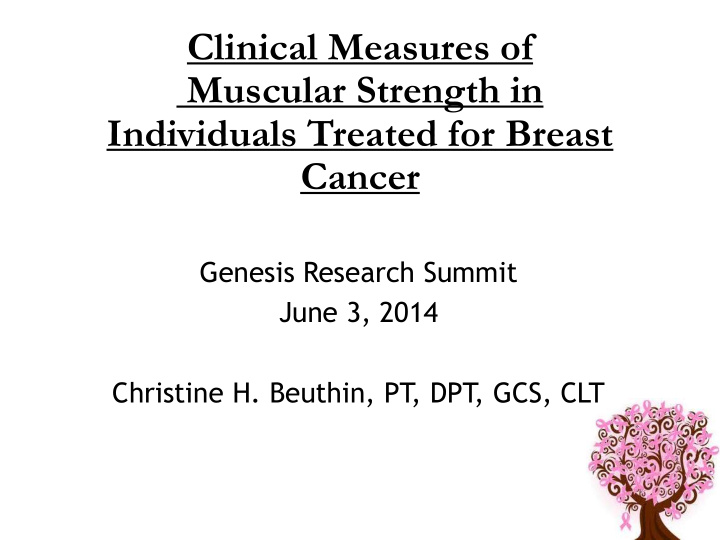



Clinical Measures of Muscular Strength in Individuals Treated for Breast Cancer Genesis Research Summit June 3, 2014 Christine H. Beuthin, PT , DPT , GCS, CLT
Session Objectives 1. Provide evidence of strength impairments in breast cancer patients secondary to cancer treatments. 2. Identify strength assessment techniques with sound psychometric properties used with breast cancer patients. 3. Recognize the role of consistency in outcome measures to assess patient status and demonstrate intervention effectiveness in individual and patient groups.
Operational Definition • Muscular strength • Force generation by muscles • The ability to resist being moved or give way to a force
Evidence of Impairment in BC Acute • Strength • Elevation strength: up to 20% deficit compared to the contralateral limb • Strength deficits up to 27% compared to age- matched controls Long Term • Strength • 8% loss in shoulder abduction strength compared to pre-operative status • 7-18% for shoulder elevation strength deficits Blomqvist Acta Oncol 2004, Harrington J Ca Surviv 2011, Hayes Br Ca Res Treat 2005
EDGE: E valuation D atabase to G uide E ffectiveness • American Physical Therapy Association • Oncology Section • Breast Cancer EDGE Taskforce
Oncology Section Task Force on Breast Cancer Outcomes: Muscular Strength Originally presented: February 2014 • Mary I. Fisher, PT , PhD, OCS, CLT • Claire Davies, PT , PhD, CLT-LANA • Cindy Pfalzer, PT , PhD, FACSM, FAPTA • Chris Beuthin, PT , DPT , GCS, CLT • Brittany Zoll, DPT • Genevieve Colon, SPT
Strength Outcome Measures • Systematic Review used to assess: • Reliability • Validity • Sensitivity to Change • Clinical Utility
Search Strategy Databases and Search Terms/Strings Sites Searched (hits with potential for (Total hits = 471 review) including repeats) Strength Google Scholar measure/measurement/ Ovid test Pubmed/Medline Manual muscle test CINAHL Psychometric Sports Discus properties/clinimetrics Web of Science Power Cochrane Review Energy PEDro Academic Search
Article Selection Inclusion Criteria • Strength measures • Strength tools • Adults, preferably female (human subjects) • English language • Clinically feasible methods • Psychometric properties reported
Article Selection Exclusion Criteria • Non-clinical measures of strength • Functional mobility measures (TUG, STS, Gait speed, etc.)
Consensus Selection • Final number of articles reviewed for inclusion: 29 • Review of testing methods – 16 articles • 13 removed as not meeting criteria (lacking psychometric data, not in compared in comparable population, lacked clinical utility) • Each outcome measure reviewed independently and rated by two reviewers • If outcome measure rating in disagreement, discussion with 4 reviewers until agreement obtained
Breast Cancer EDGE Rating Scale Oncolog ology EDGE Highly recommended; the outcome measure has excellent Highly psychometric properties and clinical utility ; the measure 4 Recommend has been used in research on individuals with or post breast cancer. Recommended; the outcome measure has good psychometric properties and good clinical utility ; no 3 Recommend published evidence that the measure has been applied to research on individuals with or post breast cancer. Unable to Unable to recommend at this time; there is insufficient 2A Recommend information to support a recommendation of this at this time outcome measure; the measure has been used in research on individuals with or post breast cancer. Unable to Unable to recommend at this time; there is insufficient 2B Recommend information to support a recommendation of this at this time outcome measure; no published evidence that the measure has been applied to research on individuals with or post breast cancer. Do not Poor psychometrics &/or poor clinical utility (time, 1 Recommend equipment, cost, etc.)
Outcome Measures Selected • Manual Muscle Testing • 1 RM Strength Testing • Hand-grip Strength • Hand-held Dynamometry
Manual Muscle Testing 6 Point Scale 0 = no contraction 1 = flicker of contraction 2 = active movement with gravity eliminated 3 = active movement against gravity 4 = active movement against gravity and resistance 5 = normal power
Final Analysis: MMT • No studies yielded a rating 3 or 4 • No studies with methodology designed specifically for the breast cancer population • High clinical utility • Reliability Poor • Rating 2B = unable to recommend
1 RM Strength Testing • 1RM defined as the heaviest load that can be moved over a specific range of motion with correct performance one time. (Pereira 2003) • Psychometric properties have not been examined in upper extremity activities • Further research is needed, especially in BCS • Rating 2B = unable to recommend at this time
Hand Grip Strength • Often used as a proxy for overall functional health • Measured with objective tool
Final Analysis: Hand Grip Strength • No studies rated 4 (Highly Recommended) • Has been used in a study of breast cancer survivors • Good but incomplete psychometric properties • Clinical Utility excellent: equipment easy to use, staff training simple • Need studies examining psychometrics in BCS • Rating 3 = recommended
Hand Held Dynamometry
Hand Held Dynamometry • Easy to use clinically • Methodology similar to MMT • Normative data available
Final Analysis for HHD • No studies yielded a rating of 4 (Highly Recommended) • Not utilized in BC population • Good psychometric qualities: reliability • Clinically feasible • Rating 3 = recommended
Muscle Strength Outcome Measure Rating Manual Muscle Testing 2B – Unable to recommend 1 RM Strength Testing 2B – Unable to recommend Grip Strength - Dynamometry 3 - Recommended Hand Held Dynamometry 3 – Recommended Limitations of Recommended Measures: Lack of validation in the breast cancer population: more research • needed Lack of MCID values: change of measure considered clinically • relevant to patient • • Lack of Hand Held Dynamometers in many clinics
Impact on Patient Care • Physical therapists can use the two recommended outcome measures to show the before and after results of treatment • This is motivational for patient as well as objective evidence of improvement in documentation reviewed by payer sources
Thank you ! Questions? 24
Recommend
More recommend